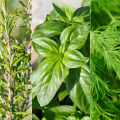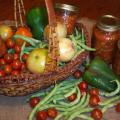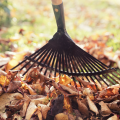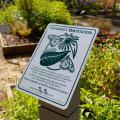Cooking With Herbs
We will never know exactly when or where people started cooking with herbs, but researchers agree that the custom is widespread and ancient - probably as ancient as cooking itself. There have been various theories put forth as to why man started using aromatic plants to season his food: to disguise the foul odor and taste of less than fresh food, to aid digestion, to stimulate appetite and on down the line.
All these theories are quite academic and joyless. Ask any six-year-old why he likes "Fruity Mint Punch" and chunks of "Herb Tea Loaf" dipped in chocolate fondue and he will simply and joyfully say, "It tastes great and makes me feel good!" What would a dill pickle be without the dill? Turkey and dressing without the sage? Spaghetti without the basil? We use herbs in our cooking because it makes it taste better--simply put.
Many novice cooks fret about how much herbs to add to a recipe, when to add, and what herbs go with what foods. There is only one rule to remember when cooking with herbs and that is THERE ARE NO RULES! The rewards and joys of using herbs to liven up your recipes is in the experimenting. For those of you who want more guidance, a table is included indicating which herbs are good with which foods. Use this as a guideline only. Experiment by adding a small amount of an herb or combinations of herbs to a dish and then taste. Add more if the flavor doesnít suit you.
Another Suggestion (Not a Rule!)
Add the herbs during the last 15-20 minutes of cooking. Certainly this cannot be done for those recipes that require the herbs to be mixed in with the batter, dressing, etc.; but for stews, vegetables and other recipes the subtle flavor is diminished if the herbs are added at the beginning of the cooking process.
Ways to Use
Cooks have so many options to use herbs that the only problem is deciding where to start. Use herbs to flavor:
- Oils
- Vinegars
- Butter/Margarine
- Breads/Desserts
- Beverages
- Meat/Poultry/Fish
- Soups/Stews
- Eggs/Cheese
- Sauces/Dressings
Finding Herbs
Fresh herbs pack the most flavor. During the warm months, gardeners can grow their own herbs and then preserve their harvest by either freezing or drying. Some area grocery stores carry fresh cut herbs in the produce section partially year round. Windowsill gardens and fluorescent lights can extend the gardener's herb harvest into the winter months. Every fresh herb may not be available during the winter months, but there is enough for culinary inspiration. Dried herbs can be found at any grocery store.
NOTE: When substituting dried herbs in recipes that call for fresh herbs, DECREASE THE AMOUNT BY HALF. For example, if the recipe calls for a cup of fresh basil, substitute with one-half cup of dried basil.
Herbilicious Recipes
Fruity Mint Punch
5 cups strong tea
2 cups fresh orange juice
1/4 cup fresh lemon juice
1 1/2 cups sugar
1/2 cup water
2 1/4 tablespoons grated orange rind
1/2 cup Kentucky Colonel mint leaves (or other mint), chopped fine
Put tea, orange juice and lemon juice in a 2-quart pitcher. In a saucepan, combine sugar, water and orange rind. Heat to boiling over high heat. After boiling for 5 minutes, remove from heat and add mint. Cover and steep for 5ñ10 minutes. Strain, put in pitcher and serve cold.
Impress Your Guests With Your Herbal Style
- An herb sprig tied to the stem of a wine glass with raffia or ribbon is simple and pretty
- Use two clear glass plates to sandwich a pattern of herb leaves
- Serve herbal butter on a leaf of scented geranium
- A single sprig or leaf in the center of an ice cube is enchanting
No Waste
- When the recipe calls for garlic and fresh herbs, mince the garlic along with the herbs. Not only do the herbs add bulk to make mincing easier; they also catch the garlic oil that is otherwise lost on your cutting surface.
Party-Time Pâté
Liven up your next get together with this festive Pâté
1 large yellow onion, coarsely chopped (3/4 ñ 1 cup)
6 cups cooked chicken, turkey or duck meat
1 1/2 cups butter or margarine
1/2 - 1 cup cream, as needed
1/3 cup Dijon mustard
1/4 - 1/2 cup fresh herbs; tarragon, sage, lemon,thyme, marjoram, basil or a combination of these
1 - 2 teaspoons hot pepper sauce
Salt to taste
Freshly ground white pepper to taste
2 ñ 3 tablespoons fresh lemon juice
1/2 cup pistachios, whole, shelled and dry-roasted
Blanched vegetables: carrots, spinach, green beans, squash, sorrel, peas, red sweet pepper, green onions or pitted ripe olives.
Process chopped yellow onion, meat, butter and cream until very smooth. Be careful not to add too much cream, or the mixture will become too soft.
When smooth, add mustard, seasonings, and lemon juice; adjust salt to balance taste; stir in pistachios. Cut vegetables into long strips, slices, or irregular chunks.
Line a loaf pan or tureen with plastic wrap, being sure to push it into corners. Spoon about a third of meat mixture into the lined pan, taking care not to shift the wrap. Smooth the surface with a rubber spatula, pushing it all the way to the edges. Put a layer of vegetables on the meat, leaving a 1/2-inch space around the edges.
Carefully add another third of meat mixture; top with another layer of vegetables. (Try to arrange each layer of vegetables at different intervals across surface.) Finish with remaining meat mixture. Smooth all the way to edges; give pan several raps to settle completely. Fold edges of plastic wrap over the top to cover. Refrigerate overnight or several hours until completely firm.
Turn out pâté onto a serving plate and carefully remove plastic wrap. Smooth out any rough or broken spots. Slice into 1/2-inch pieces and serve with toast, French bread, crusty rolls, or crackers. Garnish with additional mustard and pickled vegetables. Keeps very well for several days. If serving whole on a buffet table, a decorative layer of vegetables could be added on the top or the bottom. NOTE: This pâté softens in hot weather, so serve only at cool or normal room temperature.
Basil and Cheddar Biscuits
The tomato paste in this dough results in biscuits that are tinged orange-pink and flecked with green. The flavor is a winning combination - tomatoes, basil, cheddar, and a hint of garlic-rich and savory. No butter needed! If you want to make these during cold weather and you have no fresh basil, use about 1 1/2 tablespoons of dried basil. Crumble the dried leaves into the milk. These biscuits won't have the same perfume and taste as the ones prepared with fresh basil, but they are still quite nice.
2 cups less 2 tablespoons unbleached flour
1/2 cup whole wheat flour
1 cup whole milk
2 Tbsp. tomato paste
2/3 cup finely grated sharp cheddar cheese
1/2 tsp. salt
2 tsp. baking powder
6 Tbsp. unsalted butter
1 large clove garlic
1/2 cup finely minced basil
Preheat the oven to 400° F. Combine the flours, salt, and baking powder in a large bowl and blend thoroughly; cut in the butter until the mixture resembles a coarse meal.
In a small bowl, combine the milk with the tomato paste, blending well. Press the garlic through a garlic press into the milk and stir. Add the liquid to the dry ingredients along with the cheese and basil, and stir to form soft dough.
Turn the dough onto a floured pastry marble or board, knead gently until it just comes together, and roll out to 1/2 thickness. Cut the dough into 1 1/2 to 2 inch racks to cool slightly before serving. The biscuits are best-served warm and right after baking. If you want to prepare them in advance, cool them completely and store them in an airtight container. Wrap them in foil and gently reheat in 325° oven for 10 to 15 minutes. Makes about 2 dozen biscuits.
Herb Tea Loaf
This tender cake is lighter than pound cake and well suited for dipping in chocolate fondue.
2 cups unbleached flour
1 teaspoon baking powder
1/4 teaspoon salt
2 to 3 tablespoons minced mint or lemon balm leaves, 1 1/2 to 2 teaspoons fresh lavender or anise hyssop blossoms, or 1/2 teaspoon dried blossoms
1/2 cup milk
1/2 cup (1 stick) unsalted butter, softened
1 cup sugar
3 extra-large eggs
1 teaspoon vanilla extract
Preheat the oven to 350°F. Butter and flour a 9-by-5-by-3 inch loaf pan.
Sift the flour with the baking powder and salt and set aside. Stir the herbs into the milk and set aside.
Cream the butter and sugar. Beat in the eggs, one at a time, until the mixture becomes light and fluffy. Add the vanilla and blend well.
Add the flour alternately in three parts with the milk. Pour the batter into the pan, spreading it evenly. Bake for 45 to 50 minutes. The loaf is done when the top is golden brown, the edges pull away slightly, and a cake tester inserted in the center comes out clean.
Cool the cake in the pan for 10 minutes, then turn onto a rack. When cool, cut into 1-inch cubes and use as fondue dippers.
Basil Pesto
2 cups fresh basil leaves, removed from stem
1/2 cup fresh parsley leaves
1/2 cup olive oil
2 garlic cloves, peeled
Salt and freshly ground pepper to taste
1/4 cup roasted pine nuts
1/4 cup fresh Parmesan or Asiago cheese
In a blender or food processor, puree the basil, parsley, oil, garlic, salt, and pepper. Add the nuts and the cheese and process briefly until the pesto reaches the desired consistency. Makes 2 cups.
Classic Herbal Dressing
1 cup vegetable or olive oil
1/4 cup lemon juice or red wine vinegar
1/4 cup water
1/3 cup fresh parsley leaves and tender stems
2 tablespoons fresh marjoram, chopped
1 tablespoon fresh thyme, chopped
2 tablespoons fresh basil, chopped
1/2 teaspoon celery seed
1 clove garlic
1 teaspoon salt
1/2 teaspoon hot pepper sauce
Place all ingredients in blender and mix at low speed till nearly smooth, then at high speed for 30 seconds. Taste for salt. Use for salad greens or to marinate cooked or raw vegetables. Makes 1 1/2 cups.
Note: Substitute 1 teaspoon dried herbs per 1-tablespoon fresh measurement. You may also substitute 1/2 cup white wine vinegar for lemon juice or red wine vinegar and water.
Oven-Roasted Vegetables with Herbs
This is a comfort food in every sense. Not only are roasted vegetables easy to prepare, but they are as satisfying as seeing an old friend. As alternatives to the ingredients listed, consider white potatoes, winter squash, and sage. "Soft" vegetables such as summer squash or mushrooms also roast but need only 30 minutes to cook.
3 sweet potatoes, peeled and cut into 1" pieces
3 carrots, peeled, halved crosswise, then lengthwise
2 onions, peeled and cut into 8 wedges
1 garlic head, separated into cloves and peeled
1/4 cup minced fresh rosemary leaves
1/4 cup minced fresh thyme leaves
3 tablespoons olive oil
Heat the oven to 400° F. In a large bowl, toss together the sweet potatoes, carrots, onions, garlic, rosemary, and thyme. Drizzle on the oil and toss again. Spread the mixture on a large baking sheet and bake, stirring occasionally for 1 hour, or until golden and tender. Add salt and pepper to taste, transfer to a platter, and serve.
Most Elegant Rose Geranium Pound Cake
This famous cake freezes well and is equally delectable served with fresh fruit or vanilla sauce in place of the Lemon Curd.
10-12 rose geranium leaves, stems removed
1 1/2 cups butter
3 cups vanilla sugar (or add 1 teaspoon vanilla extract if using plain sugar)
5 eggs
3 cups sifted flour
6 ounces lemon-lime soda (do not use diet soda)
1 tablespoon fresh lemon juice
Lemon Curd (Below)
Additional rose geranium leaf for garnish
Grease and flour a 10-inch Bundt or tube cake pan. Place geranium leaves face down on bottom of pan, tearing some leaves apart to fill in completely. Preheat over to 325°.
Cream butter and sugar with electric mixer until light and fluffy. Add eggs, one at a time, beating well between each addition. Add flour alternately with soda, beating well. Stir in lemon juice.
Pour batter into prepared cake pan, smoothing top. Bake 1 - 1 1/4 hours. If necessary to prevent overbrowning (ovens vary), place a piece of aluminum foil lightly over the cake toward end of baking. After cake is removed from oven, cool for 10 minutes and invert carefully on plate.
Slice cake and serve with warm Lemon Curd. Garnish with fresh rose geranium leaf. Yields: 15 - 20 slices.
Lemon Curd
This excellent sauce has a multitude of uses - ice cream topping, pie filling, pudding garnish, cake frosting, to mention a few ñ and it keeps well in the refrigerator.
2 whole eggs
2 egg yolks
1 cup sugar
2/3 cup fresh lemon juice
1 cup butter
Mix all ingredients in blender or mixer. Cook in stainless or ceramic double boiler till thickened, stirring constantly. Serve warm. Refrigerate leftover sauce and reheat in double boiler to serve. Yields about 2 cups.
Variation: Once sauce is thickened, stir in chopped sweet herbs ñ rose geranium, mints, lemon verbena or rosemary.
Herb Cooking for Kids
(Or How to Make a Big Mess)
Children love to help in the kitchen. They especially love cooking with herbs because herbs smell so good and they get to channel their energies into smashing, chopping, grinding and beating the daylights out of things and itís acceptable behavior!
Make it a real occasion-- setting the table, brewing the tea, making an herbal centerpiece, preparing the herbal snacks - making it a very special treat. The herbal snacks can be something as simple as mint jelly dabbed on the top of a sugar cookie or chopped sage mixed into a soft cheese and spread on crackers.
Peter Rabbit's Tummy Tea
Bring 3 cups of water to a boil. Add 3 tablespoons of dried chamomile flowers and 6 whole cloves. Immediately remove from heat, cover and steep for 20 minutes. Strain and sweeten with sugar, honey or dollops of mint jelly. Chamomile has a soothing effect on rowdy youngsters helping to turn them into perfect little ladies and gentlemen at least for a few minutes!
Purchased tea blends can be easily altered into special treats by the addition of spices (cloves, cinnamon) or herbs (lemon verbena, pineapple sage, bee balm, anise hyssop, lemon balm).
Rosemary Shortbread
These tea cookies are rich, crumbly and satisfying. Pack them away in a cookie tin, then proudly serve them at your next herbal tea party.
1 cup butter
1 cup very fine granulated sugar
3 cups flour
3-4 heaping tablespoons fresh rosemary, finely chopped
Preheat the oven to 275º. Thoroughly cream the butter and sugar. Add 2 and one half cups flour and mix. Turn out on a board floured with the remaining one half cup flour. Wrestle (knead) in the rosemary along with the flour until the dough cracks on the surface and doesn't stick to the board. Roll it one-fourth inch thick, then cut into shapes. Bake on an ungreased cookie sheet 50 minutes, or until lightly browned. Cool on racks.
"Beat It" Dip
Lot of fun for kids to make. They can get as rambunctious as they like "beating" the ingredients all together.
1 (8 ounce) package cream cheese
2 very ripe Roma tomatoes
2 teaspoons mayonnaise
1 teaspoon minced oregano
1 teaspoon minced basil
1 teaspoon minced chives
Salt and pepper to taste
Let the kids "beat" all the ingredients together. Put the dip in the refrigerator to chill overnight. Serve with chips or crackers.
Herb Chop Butter
Adult supervision needed with this recipe because kids get to use knives!
2 sticks unsalted butter, softened
3 cloves garlic, finely sliced
1 tablespoon minced basil
1 teaspoon black pepper
1 tablespoon minced marjoram
1 teaspoon minced sage
Chop, chop, chop all herbs and garlic. Combine with all other ingredients. Spread generously on bread or biscuits. Broil in oven until toasty brown. Store butter in refrigerator or can be frozen.
Publications
News
Many herbs are easy to grow in the garden or in containers. Rosemary, basil, and dill are mainstays in my garden because I like to use them while cooking in my kitchen.
RAYMOND, Miss. -- Gardeners who want to preserve their abundant harvests by canning should make their list and check it twice -- now, before it’s time to begin canning. Home canners should be sure they have the right recipes and equipment for the foods they intend to preserve. They should also make sure they inspect all their equipment.
Autumn is officially here! It’s not hard to love this time of year. Temperatures are cooling, leaves are changing, and there will be more branches than foliage soon. It’s hard not to love this time of year! As we close out this calendar year, it’s easy to convince yourself there’s not much to do in the yard. Take a break, but also take time to check off these tasks
Success Stories
Paul Cavanaugh became a Master Gardener when he came off the road as a truck driver and his wife encouraged him to find a hobby.
As Jimmy Henry’s health began to decline, his wife, Shirley, wanted him to remain comfortable, safe, and happy. When the time came for Jimmy to enter a nursing home, Shirley was determined to stay right by his side, so she went with him.
See what's new in Extension: a new monarch garden, a storytelling series will begin, the Garden Expo highlights Extension education, and Keep America Beautiful recognizes MSU Extension.







